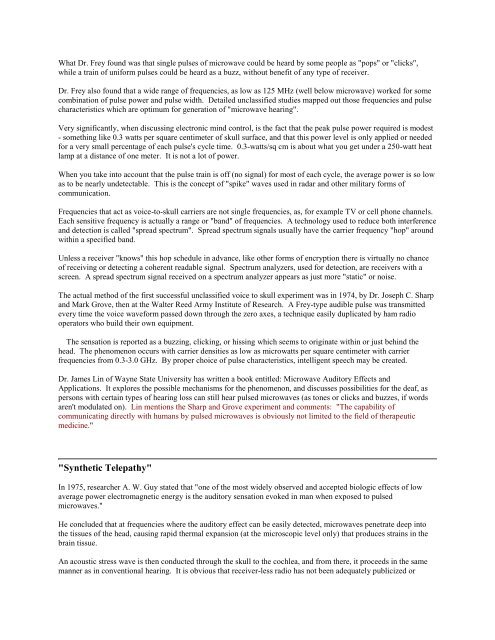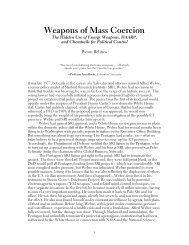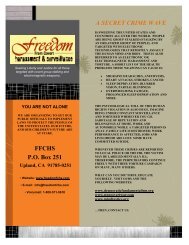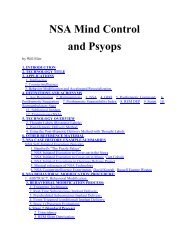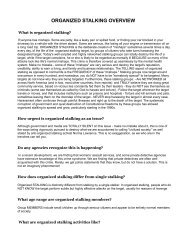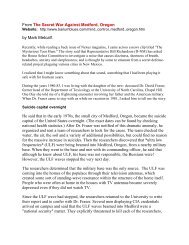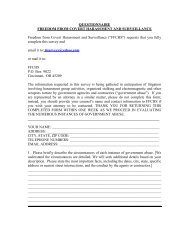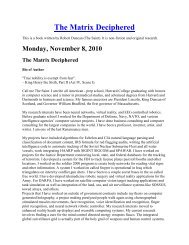Mind Control Technologies - Freedom From Covert Harassment and ...
Mind Control Technologies - Freedom From Covert Harassment and ...
Mind Control Technologies - Freedom From Covert Harassment and ...
Create successful ePaper yourself
Turn your PDF publications into a flip-book with our unique Google optimized e-Paper software.
What Dr. Frey found was that single pulses of microwave could be heard by some people as "pops" or "clicks",while a train of uniform pulses could be heard as a buzz, without benefit of any type of receiver.Dr. Frey also found that a wide range of frequencies, as low as 125 MHz (well below microwave) worked for somecombination of pulse power <strong>and</strong> pulse width. Detailed unclassified studies mapped out those frequencies <strong>and</strong> pulsecharacteristics which are optimum for generation of "microwave hearing".Very significantly, when discussing electronic mind control, is the fact that the peak pulse power required is modest- something like 0.3 watts per square centimeter of skull surface, <strong>and</strong> that this power level is only applied or neededfor a very small percentage of each pulse's cycle time. 0.3-watts/sq cm is about what you get under a 250-watt heatlamp at a distance of one meter. It is not a lot of power.When you take into account that the pulse train is off (no signal) for most of each cycle, the average power is so lowas to be nearly undetectable. This is the concept of "spike" waves used in radar <strong>and</strong> other military forms ofcommunication.Frequencies that act as voice-to-skull carriers are not single frequencies, as, for example TV or cell phone channels.Each sensitive frequency is actually a range or "b<strong>and</strong>" of frequencies. A technology used to reduce both interference<strong>and</strong> detection is called "spread spectrum". Spread spectrum signals usually have the carrier frequency "hop" aroundwithin a specified b<strong>and</strong>.Unless a receiver "knows" this hop schedule in advance, like other forms of encryption there is virtually no chanceof receiving or detecting a coherent readable signal. Spectrum analyzers, used for detection, are receivers with ascreen. A spread spectrum signal received on a spectrum analyzer appears as just more "static" or noise.The actual method of the first successful unclassified voice to skull experiment was in 1974, by Dr. Joseph C. Sharp<strong>and</strong> Mark Grove, then at the Walter Reed Army Institute of Research. A Frey-type audible pulse was transmittedevery time the voice waveform passed down through the zero axes, a technique easily duplicated by ham radiooperators who build their own equipment.The sensation is reported as a buzzing, clicking, or hissing which seems to originate within or just behind thehead. The phenomenon occurs with carrier densities as low as microwatts per square centimeter with carrierfrequencies from 0.3-3.0 GHz. By proper choice of pulse characteristics, intelligent speech may be created.Dr. James Lin of Wayne State University has written a book entitled: Microwave Auditory Effects <strong>and</strong>Applications. It explores the possible mechanisms for the phenomenon, <strong>and</strong> discusses possibilities for the deaf, aspersons with certain types of hearing loss can still hear pulsed microwaves (as tones or clicks <strong>and</strong> buzzes, if wordsaren't modulated on). Lin mentions the Sharp <strong>and</strong> Grove experiment <strong>and</strong> comments: "The capability ofcommunicating directly with humans by pulsed microwaves is obviously not limited to the field of therapeuticmedicine.""Synthetic Telepathy"In 1975, researcher A. W. Guy stated that "one of the most widely observed <strong>and</strong> accepted biologic effects of lowaverage power electromagnetic energy is the auditory sensation evoked in man when exposed to pulsedmicrowaves."He concluded that at frequencies where the auditory effect can be easily detected, microwaves penetrate deep intothe tissues of the head, causing rapid thermal expansion (at the microscopic level only) that produces strains in thebrain tissue.An acoustic stress wave is then conducted through the skull to the cochlea, <strong>and</strong> from there, it proceeds in the samemanner as in conventional hearing. It is obvious that receiver-less radio has not been adequately publicized or


